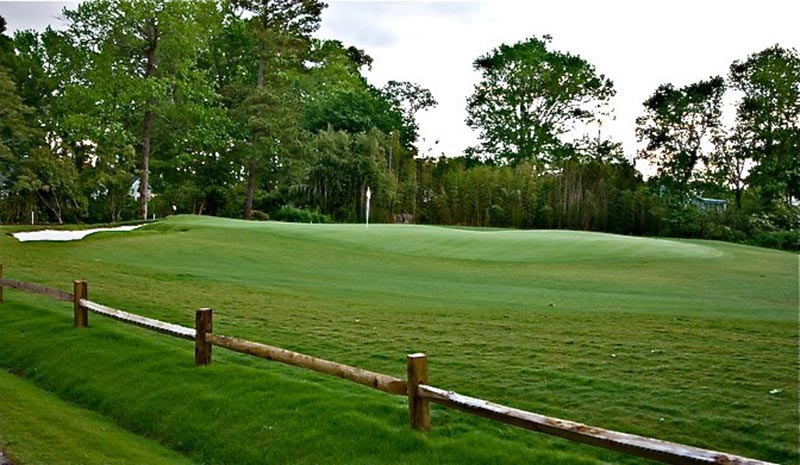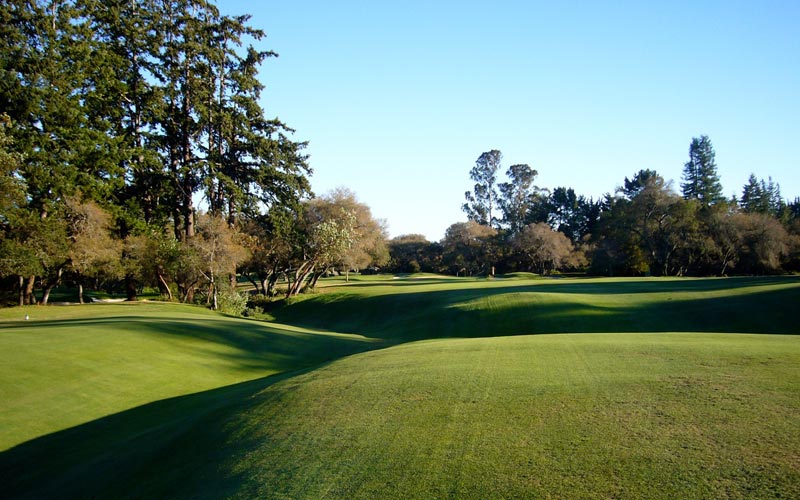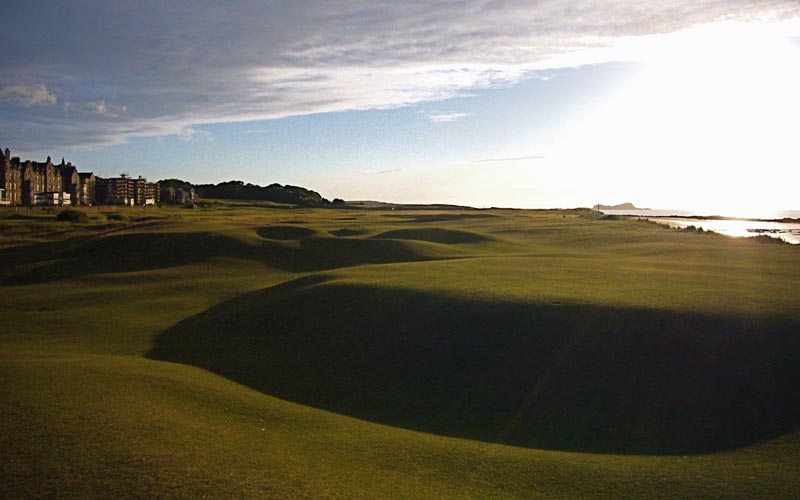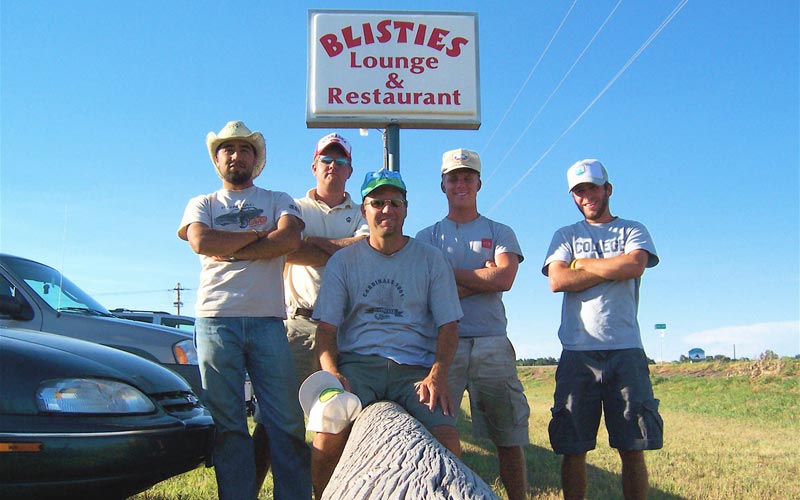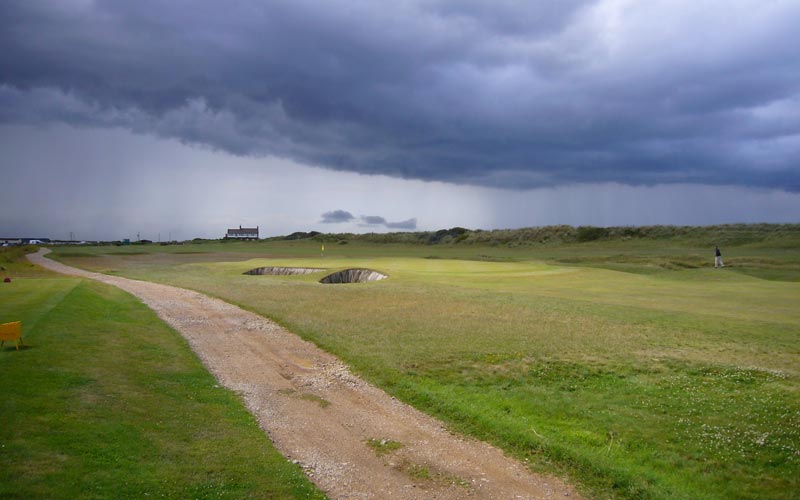Feature Interview with Kye Goalby, Part II
May, 2010
12. You have done a lot of shaping for others after you designed your own courses. Is that a direction you purposely headed?
No, not really. Obviously some might see that as moving backwards, but I love being in the field creating thoughtful golf courses. When I started at Apache with Tom I was not thinking I would only “shapeâ€, I wanted to participate on a design team doing great work. I try not to get caught up in how most people want to put everything and everyone into a labeled box. I think life is a lot “greyer†than that- even if our brains want to separate and label everything for quick associations.
It can present a challenge to alter some people’s perceptions if they think of you only as a shaper and not as someone who can both design and shape, but I am confident I can find the right avenue to do both.
Maybe it’s how I worked prior to and even while involved with Tom, but I have always thought of creating things in the field as an element of the design process and not something separate from it that you can put out to bid. If you are truly committed to creating the absolute best possible golf course I have not figured out how you can do it another way.
I still want to be involved in all elements of design, and I do really miss the mental challenge and fun of doing routings, because when I have done them I think I am pretty good at it.
Working with Tom or others though, I have never thought of myself as just shaping. I think a lot of guys that are “shapers†probably follow set plans, grade stakes, or drawings. I have never done that in 20 years. I have always been given a good bit of latitude no matter who I have worked with.
On Doak’s projects when he gives directions, it is usually in the form of a concept for the green etc, letting us use our skills and judgment to fit his idea with the land at hand. He does get much more detailed when making final edits, but in general he lets us use our brains, which is a big reason it is so much fun to work with him and why I think he can keep so many talented guys wanting to work with him.
13. You have worked with some others besides Tom Doak in recent times. What was that like?
I recently worked with Tim Liddy at Princess Anne CC, in Virginia Beach in the summer of 2007 and Dan Hixson at Wine Valley in Walla Walla, WA in 2008. On each of those projects I shaped, but I also had some creative input. How much input is hard to define. I have tried to analyze if the courses would be similar if I had not been part of the projects and while I am sure my views are biased, I do think each of these courses would provide a very different playing experience and visual presentation had I not been around.
Princess Anne
Princess Anne was a renovation of an existing residential course, so there was not a routing to do per se as the hole corridors were set. Tim reversed a par three direction which brought the Chesapeake Bay into view and vastly improved that hole, and we turned two lousy short par fours into a good par five and fun par three. Those were the extent of routing changes. But, even with few routing adjustments, the course is unrecognizable from what was there.
Tim liked the first few greens I did and let me create the greens in the field. After they were rough shaped he would direct whether or not to edit or adjust them. He also would discuss the bunkering with Will Smith and I and then let us get creative with them, as well as redo the fairway contours. It was fun and educational for me to hear Tim’s ideas and the things he has learned from working with Pete Dye. In turn, I think he enjoyed doing things in a bit of a different style than the “Dye†methods he had often done.
It was really rewarding conceptualizing with Tim and Will and turning that uninspiring 6000 yard golf course into something pretty darn interesting by creating a set of very good greens, making it much more natural in appearance and implementing some imaginative strategy. For what it’s worth, Princess Anne, a 6000 yard course, with 8 holes playing across public roads, was awarded a Golf Digest Best Remodel in 2009.
Wine Valley
I arrived in Walla Walla having never met Dan Hixson. If it was not for Tony Russell being busy starting at Old Macdonald I probably would never have set foot in Walla Walla. I was recommended to Dan Hixson by Tony, who had worked with Dan a few years earlier constructing and shaping Bandon Crossings. Tony was busy with Jim Urbina at Old Macdonald and also helping Dan with a 9 hole project he was doing in Waldport, Oregon simultaneous to Wine Valley. So, that led to me getting the call. I was supposed to do a project with Jay Haas that was delayed (forever), so all of a sudden I had time and was able to head to Walla Walla. Sometimes things just work out!
Dan had spent two or three years working on various routings and sketching out the holes. It was really his baby, but there was a lot of field design going on with what was put on the ground. It was a really big scale property and just about every piece of dirt on the golf course was probably shaped, as a lot of the valleys the holes occupied were initially a bit too narrow for golf. Also, the land, having been farmed for years, had no small contours left at all.
It was a ton of dozer work, but the soil was perfect so it went quickly and a lot of character was sdded. Dan was not rigid in his ideas and allowed me to improvise and create a lot of greens and other features on the fly. He also trusted Brian Caesar and me with the aesthetics of the bunkers- even though the first time he was away we probably made the first bunker we did on the right of number one fairway about 8 times bigger than what he flagged!
This was done because, with the immense scale of the place, “normal†size bunkers just got lost when you were on the tee. That bunker actually began the evolution of what became the Wine Valley bunker style, which was large with rather massive edges. They were actually inspired by road cuts in the hills along our route to work. Although soil, the cuts stayed stable and vertical along the roads over the years, as well as having cool bird holes in them. Incorporating this into the bunker edges seemed to give the bunkers there own unique and local character. Maybe someday birds will even take up residence in a few bunker faces! Who knows what those bunkers may have looked like if not for the route from our house to the site.
I am sure it was tough for Dan to let us get creative and to let go of some of the ideas that had been percolating in his head for so long. But, to his credit, as he gained confidence in what we were doing he was always willing to listen to ideas and the place turned out really good. I greatly appreciated Dan being flexible and allowing me a bit of collaborative input on a job so important to him. Whether that means I did more than shaping, who knows. I was just happy to get the experience to hang out in a place called Walla Walla, and get to know a lot of very cool people while there. Maybe the coolest being the unique and always affable GolfClubAtlas participant, Slag Bandoon.
14. With 19,000 golf courses to handle a sport that isn’t attracting new golfers like it once did, many people think that original course construction will take a back seat to renovating/improving what is already out there. Do you see agree with that?
I don’t know. I know we are already seeing a drastic fall in new construction and I think we will pay quite a while for the oversupply of golf courses created by the residential golf course boom.
One of the indirect elements of this, that I think has, and will hinder the growth of the game, is a ton of potential golfers exposure to playing the game was through these type of courses, and to put it mildly, bunches of them were not created with golf as the primary goal, are not much fun to play, nor do they inspire a love or understanding of golf. They have no real connection to nature and are also mostly too expensive, too boring and way too slow to enjoyably play.
Until these courses in “need†of improvement are able to be purchased for a price that allows the owners make a profit charging a fee that the marketplace responds to I don’t see where the money will come from to be spent on improvements. On top of that, on some of these courses that need the renovations you talk about, can you actually “improve†the course in a way that helps the bottom line? Maybe you could eliminate some maintenance problems, but, if a course has a lousy routing and/or a bunch of boring greens and is expensive to maintain, a band-aid or two is not likely to make a difference -except to the pocketbook of the people doing the work.
I think this old quote is very timely, and timeless, when it comes to renovating. “Remodeling and reconstruction, which results in added pleasure in the play of club members and their friends, is very much worthwhile. The result adding interest on the part of old members and to the attracting of new ones. A job which fails in doing that is nothing more than money thrown away, and is as well left undone.†– Alister Mackenzie 1933
15. Is that good or bad for you personally?
Personally, work is good, but I sure don’t want to be part of wasting a course owner’s or club’s money for the sake of getting a job. There are courses that can be helped and I hope the fact that I am honest and can design, as well as shape/build those designs (and know how to do it cost effectively) is a selling point.
16. Are you planning to do more things on your own?
I have been involved with a few projects of my own over the past few years, a lot them unfortunately never saw the light of day, including the project mentioned earlier with Jay Haas. It is, however, quite addicting working with great people on great courses and it is extremely hard to give that up to spend a ton of time trying to secure a two hole remodel on some mid-level golf course when there is an opportunity to be a part of the creation of places like Ballyneal, Rock Creek or Old Macdonald. I guess I have been spoiled!
It takes a lot of time, hard work, salesmanship and fortitude to secure a job (these days even that is not enough) and I have a ton of respect for the guys that are out there hustling, selling and successfully doing that. I definitely want to have more involvement in all aspects of course design, whether on my own or with others, but recently I have been focused on being part of a team trying to build great courses rather than getting out there trying to get my own commissions. With the present state of the industry, and so little work happening, staying solvent will likely require working every avenue available and quite possibly having an alternate (or primary!) income source.
17. Suppose I have 200 acres of land here in the sand hills of North Carolina for a walking only golf course. The sandy site is mostly open and only a few trees might have to be felled. There will be no practice area as there isn’t room. Ignoring the cost of the small clubhouse and parking lot, what are the primary costs for building a course on such a site?
So is this the job I can use to jumpstart my design career? 🙂
I will assume you have found a piece of land with a good water supply as well as access to three phase power and have no environmental restrictions….. Easy!
The sandy site with an existing lake obviously helps keep costs down as water supply is already there and greens and hopefully bunkers will be created from native soil.
The other important and obvious aspect is a thoughtful routing that truly uses the land in a unique way that gives the course its own identity and requires very little earth movement between tee and green. We would likely make some enhancements to a few features to add some interest or drama to a few holes while shaping. The shaping and feature construction would be done by me and hopefully a couple others who would be on site full time during construction.
That being said, the back of napkin cost estimates starting from the most expensive and moving down the list:
• Irrigation two and three row system – pump station, three phase power to pump, pipe, heads, install.
$700,000
• Design fee and feature construction – design fee, shaping fees, labor, housing, transportation, equipment rental, fuel, equipment maintenance
$675,000
• Greens superintendent and small crew to help with labor during construction
$175,000
• Grassing. Assuming all Bermuda including greens. Sprigging/ seeding/hydro-mulching/sod and seed bed prep
$150,000
• You will also likely need a well to supply water to the existing lake, but the cost and feasibility of that is hard to predict in this scenario.
Total, not including grow-in, maintenance buildings and infrastructure = $1,700,000
18. Wow! That’s not much. Then when/where did golf course construction become so expensive?
Well, first off you had a course on sand and did not include land costs. Second by doing a design/build and with the hypothetical routing requiring a minimal disturbance there were some cost savings. While I am certainly not saying all of the following is necessary, if you had clay type soils there are additional ballpark costs that courses built recently would likely have – in addition to those we mentioned above. They are:
• USGA type greens construction (700k to 900k),
• Drainage for bunkers, tees and fairways (300k to 500k)
• Cart paths (500k to 1m+)
• Bunker sand (up to $50+ per ton).
• Lake construction for irrigation water storage is a big cost variable, especially if excavation and a permitted dam is needed and lining of the lake is required (200k to 500k)
Additionally, items that became kind of commonplace in a lot of expensive golf in the recent past were:
• Sandcapping or USGA greens construction of tees
• Sandcapping of fairways (some do it)
• Major earthwork – including stripping stockpiling and replacing topsoil (500k +++)
• Blasting rock where needed to put holes that don’t really fit
• Stone retention walls
• Wall to wall cart paths
• Cart path curbs
• Aggregate cart paths
• Environmental permitting and mitigation
• Additional lake building
• Artificial, recirculating streams
• Extensive to complete sodding
• Gonzo landscaping
• Huge trees moved with spade
• Extra (or excessive) irrigation- more heads more pipe, more wire, more lake, more pump etc. including misters for bunker faces and other areas,
• Waterfalls!
• AND of course, gigantic clubhouses
19. What are three design features that you would like to see more of (front to back greens, etc.)?
1. Fairway undulations in lieu of hazards; think the fourteenth at Pasatiempo or second at North Berwick
2. Less Bunkers, but bunkers that are strategically significant and built to utilize terrain that feed balls into them (yes that means water would also go in them but if they are built with that fact understood, and don’t drain onto flashed sand faces, so what, they have drains in them, right?!).
3. No rough. Probably not cost effective with bent grass, but with all other types, just gang-mow the golf course and have some native grasses in out of play areas (no time wasted ball hunting).
4. Green sites (and turf conditions) that for the most part allow the ball to approach along the ground to insure the course can be fun for everyone, in all conditions. Who knows, on occasion, maybe even the good player will contemplate his method of approach?? Oops, that’s four.
20. What are three things you would like to see less of?
1. Catch basins in chipping areas around greens. If you are creating a hollow around the green and it won’t, or you can’t make it surface drain without a basin, do something different.
2. Square tees.
3. Two dimensional lacy edges on bunkers created by edging along wiggly lines painted by someone on a flat, dozer built surface. The bad (to me) assembly line versions of the “naturalâ€, “eroded†style bunker has me longing for something very different.
21. How, if at all, has the profession of golf course architecture changed over that period of time?
I think the adoption of the classic look, if not exactly the classic strategy stands out. When I first started it was generally all about building mounds, bulkheads etc. You don’t see too many new courses with mounds all around the greens or down the sides of fairways. You definitely saw lots of that being built when I started in 1989. I think, even when you take into consideration the lip service, there is more respect for the land these days, especially from the younger architects.
I have actually seen a few new courses where younger guys, in trying to utilize the land as is, actually should have moved more earth. I wonder if this is influenced in any way by some of the shaping/earth work done on Doak’s courses, as the finished look may trick people into thinking nothing was created. When in fact it was created, you just can’t tell.
The last year or so though has provided the biggest change in the profession, as the whole model of what “worked†has come crashing down and lots of guys will probably never participate in it again. I hope everyone in the golf industry takes a hard, insightful look at what it is going to require to make a course profitable as a standalone product. I also hope, with my skill set, I can be one of the people working to make that happen. We shall see….
But, for me personally, the absolute biggest change over the past 20 years has been the introduction of the iPod! Spending a day on the dozer or track hoe-especially one of the monotonous days just shoving dirt – with 800 cds, all kinds of podcasts and a few audio books in your pocket is a colossal upgrade from being blasted by the constant machine noise – and on occasion a few too many thoughts!
22. What do you listen to most?
Really a lot of different things all over the “rock†genre, but one artist who is inspiring when trying to be creative is Beck. The way he can take so many different “ingredients†to come up with something very sonically tasty and unique is pretty amazing. He also is always exploring new avenues and styles and I try to listen to his music with the hope I can absorb some of that creativity, be open and observant and maybe be inspired to use seemingly unrelated and unique objects or features to enhance my work.
23. Throughout your travels in the past several years, what are some of the neatest features/holes that you have seen? Why do they stand out to your eye?
1. The first “feature†that comes to mind is the “Serration Nation†or blurring of the transition between native and maintained turf at Ballyneal. It was a very cool and creative integration of the golf hole to its environment. I know Rupert, the owner at Ballyneal, understood it very well and I hope in the long-term maintenance they keep a focus on it, as that look, to me, is a huge part of what makes Ballyneal unique.
Tom and Bruce Hepner get credit for the genesis of this and then a lot of thought, sweat and sunburns from Jonathon Reisetter, Mike McCartin and the whole crew who randomly cleared the periphery of the holes and made it come to life
As long as I have known Bruce he has always had a keen appreciation and artistic eye for grassing lines and their importance. Over the years he made me, and I am pretty sure everyone else at Renaissance, aware of grassing lines and of using them (which often actually means hiding them) in the creation and presentation of the golf hole. The “serration nation†took it to a new blurry level.
Once you grasp and see the importance of grassing lines it really adds a great weapon to your arsenal when building or renovating a course. Very few architects, superintendents or golfers seem to actually comprehend this, so it can be real valuable tool to have in making your work stand out…. by blending in.
2. The routing of Rock Creek. That is an amazing property, but it is expansive and with a lot of elevation changes. How Tom (with an assist by Eric Iverson) was able to take the golfer on a meandering tour of the wonderful variety of that landscape, keep it walkable, and even a bit intimate, while finding amazing holes that did not require a lot of earth movement (besides what seemed the eternal removal of boulders from playing areas) was/is a real marvel.
3. The bunkering at Lawsonia (and also what originally was on the front nine at West Bend). Having grown up on a Langford course (with no fairway bunkers), I have a soft spot for all of his work. In the summer of 2009, with a lot of free time, I finally got to Lawsonia. The way Langford set up play with the offsetting, perpendicular nature of the dramatic large-scale fairway bunkering creates so much strategy for all levels of player. I saw some of this first at Harrison Hills years ago, but Lawsonia is the best example of his genius. I am thankful I had a chance to finally get there. Also, very graceful work by Ron Forse and Jim Nagle there to show off Langford’s talents- without showing their hand or spending a ton of money.
4. The cool atmosphere and golf course at Royal West Norfolk. It is just a great example of what I think a golf club should be.
It is integrated with its community (public beach access between the clubhouse and first tee!) and it is simple, natural (even with bulkheads), unpretentious, a bit wacky, easily walkable, easy to maintain and fun for everyone. I was not familiar with it before visiting there with Brian Schneider last year, but I sure hope to get back there soon!
5. At least three things on probably every hole at North Berwick
The End


